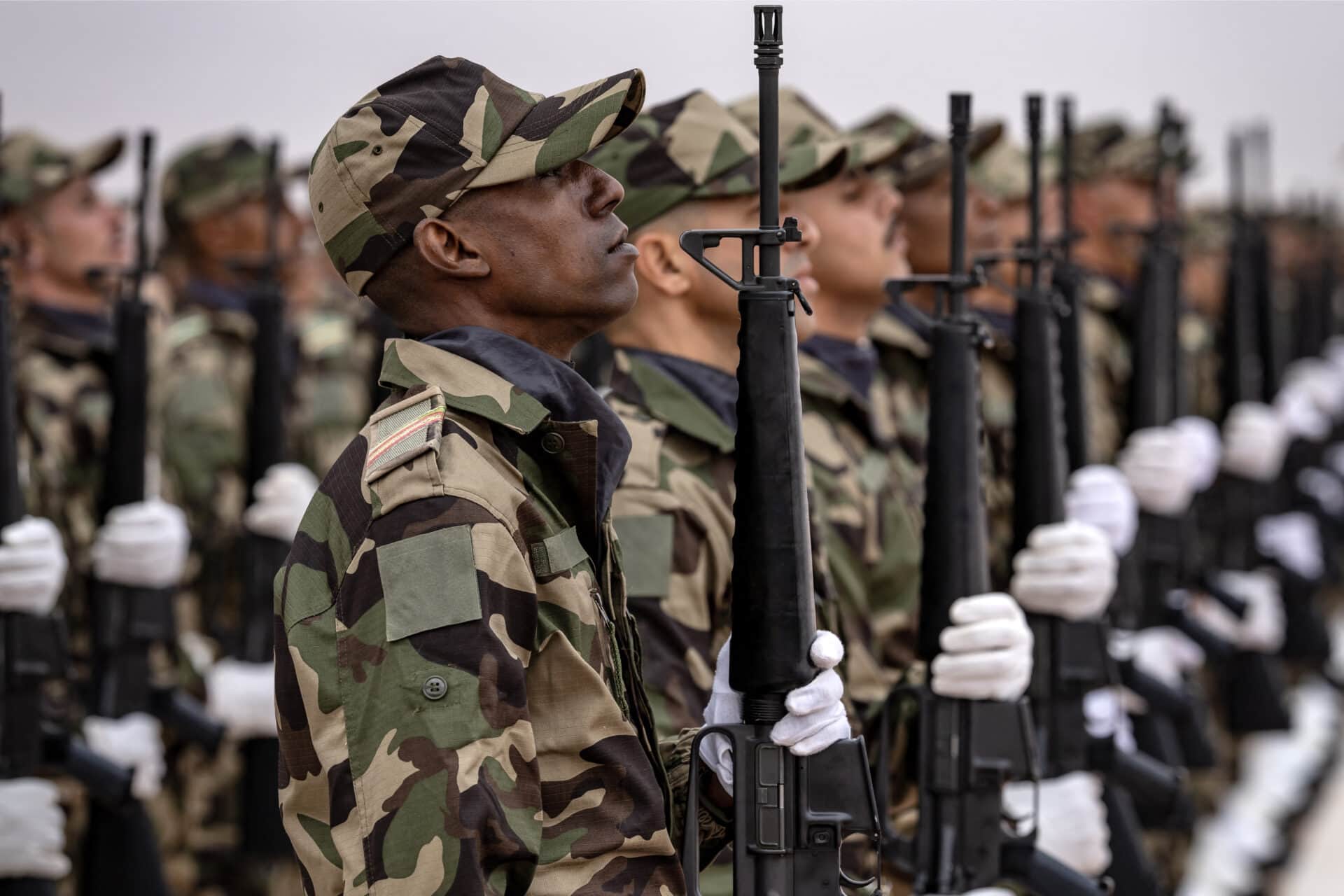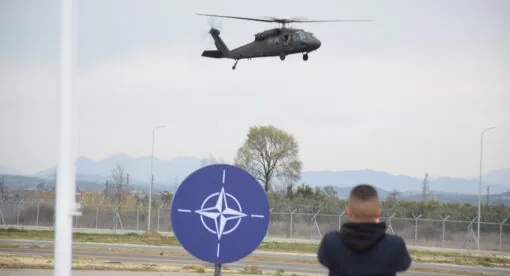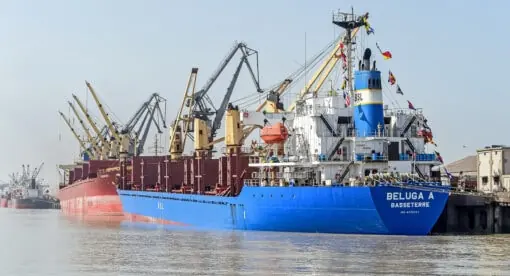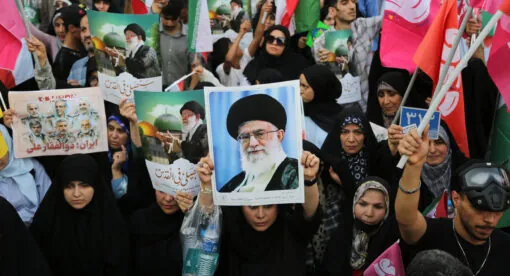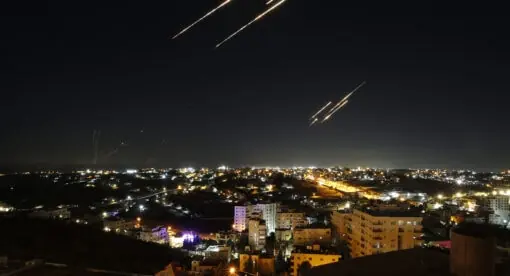With U.S. partnerships in the Sahel collapsing, Morocco and Mauritania are emerging as stable North African anchors, offering strategic geographical positioning, political steadiness, and discreet but sustained security cooperation. Their geography, posture, and reliability offer a viable path to preserve U.S. access and manage regional fallout without entanglement in fragile partnerships or costly deployments.
Once a counterterrorism hub for a U.S. and French military presence and joint operations, the Sahel region of North Africa has devolved into instability, marked by coups and extremist violence amid great-power competition. Over 5.6 million people have been displaced, trafficking routes, primarily for drugs and arms, but increasingly for migrants and fuel, are expanding, and U.S. troops have been forced to scale back their presence, losing access to key coordination hubs. The collapse of the Sahel engagement model is now a fact, not a forecast, a reality underscored recently by Marine Corps Gen. Michael Langley, the leader of the U.S. Africa Command (AFRICOM), who described the region as “the global epicenter of terrorism” and noted that the U.S. has lost much of its ability to monitor extremist networks closely.
But disengagement must not erode U.S. visibility and access. Washington still has critical stakes in the region: preventing encroachment as Russia, China, and Iran deepen regional mining, security, and political ties; protecting strategic minerals in unstable and contested zones; and shielding Atlantic and Mediterranean corridors from destabilizing spillover, as armed groups and trafficking networks push north.
At a time when Sahel engagement has collapsed, Morocco and Mauritania help the U.S. protect three essential fronts: economic security by safeguarding critical mineral supply chains; geopolitical positioning by containing Chinese, Russian, and Iranian influence; and physical security by filtering the spread of terrorism, trafficking networks, and regional collapse.
Rather than continuing to deal with unstable partners or fragmented regional frameworks, Washington should pivot to a perimeter strategy, anchored not in the Sahel itself, but along its northern edge. It is a posture grounded in the same principle that has informed U.S. engagement in a number of regions through limited, flexible military presence with stable regional partners. This model is reflected in Cooperative Security Locations, where the U.S. maintains temporary access arrangements without permanent basing, as seen in countries like Jordan, Kenya, and the Philippines. That same principle can apply here: Morocco and Mauritania as a functional buffer for intelligence, trade, and strategic influence without the risks of extended involvement.
From Fragile Engagement to Strategic Withdrawal
The collapse of the Sahel’s Western-aligned security architecture reflects more than a breakdown in partnerships. It marks the unraveling of a nearly two-decade U.S.-French counterterrorism presence , eroded by successive coups and growing anti-Western sentiment. From 2020 to 2023, military juntas in Mali, Burkina Faso, and Niger toppled civilian governments and severed ties with Western allies, prompting the suspension of U.S. security cooperation in Mali and Burkina Faso. In 2024, Niger, once considered Washington’s last viable partner in the Sahel, revoked its defense agreement with the U.S., closing drone operations at Air Bases 101 and 201, the country’s primary hubs for U.S. surveillance and counterterrorism missions. France’s ambassador was expelled, and the G5 Sahel joint force collapsed as key members withdrew, citing sovereignty concerns and frustration with Western influence.
This cascade of exits has left Washington increasingly isolated. In the months since, the United States has not articulated a clear alternative for its Sahel strategy. With operations wound down and partnerships in retreat, it lacks a functional presence in a volatile zone. Absent a coordinated pivot, U.S. engagement risks becoming reactive rather than strategic, highlighting the need for a recalibrated approach that safeguards visibility and leverage amid regional collapse.
As the Western presence faded, others moved in. Russia’s Wagner Group entrenched its presence through mining concessions and direct access to ruling juntas – its operational footprint most visibly demonstrated by its alleged role in the 2022 Moura massacre in Mali, where hundreds of civilians were reportedly killed. Wagner has since rebranded as Africa Corps under the Russian Defense Ministry and GRU control. While its tactics have shifted from frontline combat to advisory and training roles, the core mission endures. Iran, less visible but persistent, expanded ties through arms deals and religious outreach, funding Shia institutions in Niger and Mali. China deepened its footprint through infrastructure development, mining contracts, long-term financing, and limited military training.
U.S. influence in the Sahel has eroded across military and diplomatic fronts. Troops were redeployed elsewhere, military cooperation suspended due to legal constraints on postcoup regimes, and development aid slashed following USAID’s dismantling under the Trump administration. A shift from a “whole-of government” to a “cost-sharing” model has added a layer of strategic ambiguity to U.S. engagement, underscoring the absence of a clearly defined path forward. By contrast, Russia and China offer transactional alternatives free from legal or reputational cost.
Meanwhile, regional security continues to unravel. Al-Qaeda- and Islamic State-linked groups have exploited power vacuums and porous borders, killing over 3,885 people in 2024, accounting for over 50% of global terrorism deaths. Deaths attributed to terrorism in Niger rose 94%, and Burkina Faso now accounts for one–fifth of global terrorism fatalities. In Mali, terrorist groups have consolidated control, reaching the capital, Bamako, and briefly closing its airport. As terrorist networks expand, drug trafficking routes have spread across ungoverned zones, threatening coastal states and Mediterranean corridors.
Amid this volatility, Morocco and Mauritania stand out as stable partners. Their robust state institutions, effective border surveillance, and low exposure to Sahel insurgency zones have helped them prevent infiltration and sustain U.S counterterrorism cooperation.
The U.S. cannot rebuild a region that rejects engagement, but it cannot afford to look away, either. A pivot is needed: not an attempt to salvage broken alliances, but to build strategic depth from the edge.
Morocco and Mauritania: A Functional Firewall for a Shifting Perimeter
In a region of unraveling partnerships, Morocco and Mauritania stand out as functional anchors, offering the operational reliability, geographic leverage, political stability, and institutional steadiness essential for a perimeter-based strategy.
Though not formally aligned, the countries coordinate discreetly on shared border management, including through joint military commission meetings and intelligence coordination concerning trafficking and extremist infiltration from the Sahel. Their partnership also spans infrastructure, including transport corridors and electricity interconnections, as well as training, and energy cooperation. The Guerguerat corridor, connecting Morocco to Mauritania and sub-Saharan Africa, offers Rabat trade leverage and early warning intelligence. A new border crossing near Polisario-held territory quietly expands its reach.
Growing bilateral cooperation marks a strategic shift, as Mauritania historically maintained a cautious distance, navigating Morocco’s past claims and Algeria’s regional weight, before moving to quiet alignment.
Morocco’s institutional and logistical assets underpin its stabilizing role. Though the Western Sahara conflict remains formally unresolved and a source of regional tension, especially with Algeria, it has not disrupted its internal stability or reduced U.S. confidence in Rabat’s reliability; rather, it reflects institutional discipline and a consistent, calibrated approach to both diplomacy and domestic control. The region functions as an integrated part of Morocco’s economic and security system, with the cities of Laayoune and Dakhla emerging as stable, well-governed hubs for logistics, trade, and renewable energy, far removed from Sahelian volatility. Since U.N. Security Council Resolution 1754 in 2007, international framing has shifted away from the original U.N.-backed proposal for a self-determination referendum in the Western Sahara, toward a political solution centered on Morocco’s autonomy plan, increasingly described as “serious and credible.” That autonomy plan is now endorsed by 116 U.N. member states including the U.S., France, Spain, Germany, and the U.K. Several European governments have gone further by committing to direct investment in the territory.
Morocco maintains close security ties with AFRICOM and hosts the annual U.S.-led African Lion military exercises. While other nations also participate in African Lion, Morocco plays a logistical role with deeper infrastructure integration and longstanding interoperability with U.S. forces.
These capabilities complement Mauritania’s discreet but reliable role in the region. Nouakchott has anchored its strategic posture along a porous and volatile frontier with Mali, sustaining its buffer role through quiet collaboration with European and U.S. partners on intelligence sharing and training. Despite limited security manpower and underfunded state institutions, it has managed to deter terrorist infiltration via targeted patrols and community-based intelligence.
Mauritania’s strategic value lies in its deliberate restraint, avoiding regional overreach, ideological entanglements, and the signaling wars that often undermine reliability in fragile contexts. Instead, it offers quiet access through steady intelligence-sharing, credible coordination along its long and exposed border with Mali, and diplomatic flexibility in its dealings with Western, African, and Arab partners. At a time when visibility can trigger backlash, Mauritania’s low profile and functional posture enhance its value for U.S. engagement.
Under President Mohamed Ould Ghazouani, Mauritania has preserved civilian-military stability after decades of coups and is positioned to benefit from an anticipated natural gas windfall, although its long-term value depends on governance. The country also hosts one of the longest freight railways in Africa, underscoring its logistical value.
This stabilizing role sets the two countries apart from potential alternatives whose regional posture has become more constrained, in particular Algeria, whose positioning has sharply deteriorated. Its rupture with Morocco, coupled with strategic ambiguity in its ties to Russia and Iran, has reduced its diplomatic reliability. More critically, Algeria is now cut off from its southern depth, not by geography but by the Sahel’s unraveling and the collapse of its once-crucial ties with neighboring states. Tensions have escalated with Mali despite Algeria’s efforts to cast itself as a mediator in its internal conflict. The 2015 Algiers Accord, once viewed as a cornerstone of that diplomatic effort, has effectively collapsed amid growing distrust. Tensions peaked in March after a Malian drone was downed near the border town of Tin Zaouatine, further exposing the fragility of bilateral ties and prompting both governments to recall their ambassadors and close their airspace to one another.
That rupture deepened in April when Mali, Niger, and Burkina Faso, now aligned under the Alliance of Sahel States (AES), a confederation formed in 2023, collectively withdrew their ambassadors from Algiers. No longer bilateral, the deterioration reflects a broader regional realignment, limiting Algeria’s southern influence. The drone episode was merely the most visible flashpoint in a deeper rift. The AES states’ reliance on Russian mercenaries has rattled Algiers, which despite its alignment with Moscow rejects the use of nonstate actors near its borders.
Tunisia lacks the capacity to project stability amid deepening political paralysis under an increasingly authoritarian drift and economic decline, while Libya, split between rival governments and militia networks, remains fractured beyond any cohesive operational role. Togo, Benin, Côte d’Ivoire, Guinea have drawn increased U.S. attention under the Global Fragility Act, a 2019 law coordinating efforts to prevent conflict and build state capacity in fragile settings. These countries face expanding terrorist threats along their northern borders, limited surveillance, and gaps in military readiness. Togo and Benin have seen repeated cross-border attacks since 2021, with few troops stationed in those areas. Côte d’Ivoire combines economic strength with rising security pressure in the northeast and persistent political stability. Guinea, under military rule, is ineligible for full U.S. security partnership. While Senegal remains relatively stable, its northern terrorism exposure is growing, and its location, distant from core Sahel flashpoints, limits its utility as a strategic platform.
None of these countries offer the geographic depth, institutional resilience, and strategic alignment of Morocco and Mauritania. Other countries in the region are either consumed by internal instability or focused on immediate security threats, reinforcing Rabat and Nouakchott’s unique role as credible outer anchors for a recalibrated U.S. strategy.
Strategic Minerals and the Atlantic Corridor: A Layered Opportunity
Containment is not only about security; it also requires securing access to strategic assets. The Sahel holds major critical minerals reserves, essential to U.S. energy and defense supply chain. Niger holds 5% of global uranium reserves and is a key supplier to European and global nuclear industries. Guinea possesses roughly one-third of the world’s bauxite and exported nearly 100 million tons in early 2025, while Mali holds an estimated 21 million tons of lithium-rich ore. Burkina Faso accounts for 2% of global gold production, making it a key node in the Sahel’s mineral corridor. Yet most of these resources are located in high-risk zones.
The U.S. sources its critical minerals mostly from stable partners like Chile and Australia but remains exposed to chokepoints, particularly in China-dominated processing and export infrastructure. Even imports from trusted sources often pass through Chinese-owned hubs, creating indirect dependencies the U.S. cannot offset. This vulnerability is compounded by China’s expanding control over mineral routes across Africa. Moreover, while the Sahel is not a major supplier to the U.S. now, its untapped reserves and growing ties to rival powers make it a strategic front in future competition. As a global demand rises, driven by energy transition and great-power rivalry, control over the routes, not just the resources, will shape geopolitical leverage.
China’s grip on West African mineral corridors is deeply structured. Nowhere is this more evident than in Guinea, where Chinese firms control the logistical chain from rail to port. This model is echoed across the region though with varying depth. In Nigeria, a 75% stake in Lekki Port secures a rising shipping hub. In Togo and Cameroon, Chinese firms hold partial or majority stakes in the Lomé and Kribi ports, respectively. While Côte d’Ivoire and Senegal offer stable ports, weak inland connections limit their strategic utility.
Russia, less invested in logistics, has secured upstream access in Mali and Niger through military alignment, embedding itself in lithium, uranium, and gold sectors.
In this fragmented landscape, a new African-led corridor is emerging focused on integration, not extraction. In 2023, Morocco launched its Atlantic Initiative, a regional framework intended to open maritime access for landlocked Sahel countries through ports like Dakhla. While not designed for U.S. purposes, the initiative aligns with American priorities in building alternate corridors outside Chinese control.
Its backbone includes the $1.2 billion Dakhla Atlantic Port (partial operations are expected to begin by 2026), and the Nigeria-Morocco gas pipeline, a $25 billion transcontinental energy corridor running through 11 West African countries to Europe, whose first phase launched in July.
Morocco’s OCP, a global producer of phosphate-based fertilizers with operations in 16 African countries, already plays a broader role in supporting regional industrialization, building plants, logistics hub, and transport links to strengthen trade infrastructure across the region. Mauritania’s Nouadhibou and Nouakchott ports, though smaller than regional hubs like Dakar, offer valuable waypoints when paired with its 700-kilometer (435-mile) mineral railway and active iron exports and are well positioned to complement broader Sahelian transit routes under development.
Momentum behind this initiative grew in April, when King Mohammed VI hosted the foreign ministers of Mali, Burkina Faso, and Niger in Rabat. The Sahelian states formally endorsed Morocco’s offer to provide Atlantic port access through Dakhla and other coastal infrastructure. Their participation underscores a broader regional shift, where landlocked states are turning to Morocco for connectivity after exiting the Economic Community of West African States (ECOWAS) and facing trade restrictions.
For the U.S., these are not ready-made partnerships but real openings to strengthen resilient supply chains and build smarter, more reliable logistics without direct involvement. They also represent a rare convergence of regional momentum and strategic alignment, one that Washington can engage through strategic accompaniment. Rather than lead or step back entirely, Washington can support the initiative by helping streamline border and customs procedures, strengthen corridor governance, and reduce investment risks through targeted development finance. Risks remain, including sustained insecurity, weak cross-border coordination, institutional fragmentation, and long-term financing gaps. However, the cost of disengagement is higher, ceding influence to assertive competitors and missing the chance to anchor a long-term Sahel strategy in African-led economic integration.
Managing Great-Power Competition from the Edge
Beyond defense, this firewall strategy offers a way to compete with China, Russia, and Iran without costly entanglements. It allows Washington to monitor, influence, and contain great-power ambitions from the perimeter rather than the core. Yet this approach is not without risks. It may yield diminishing returns if regional partners lack follow-through, or if adversaries learn to sidestep perimeter containment through asymmetric tactics or proxy influence.
Morocco and Mauritania provide the United States with monitoring access, regional leverage, and stable political terrain absent direct confrontation. This perimeter-based approach enables the U.S. to shape the operating environment without deep entanglement. It reinforces resilience by preserving trade corridors, constraining adversarial expansion, and maintaining situational awareness in a volatile region. Rather than contesting influence in unstable centers, the U.S. can exert strategic pressure from the margins. Success would not be defined by excluding rivals entirely but by preserving U.S. access, avoiding strategic surprises, and slowing China’s and Russia’s advance.
Policy Blueprint: Reposition Without Overreach
A Morocco-Mauritania perimeter strategy requires no new regional architecture, just an expansion of existing tools. Still, implementation carries quiet political sensitivities. Morocco’s outreach to Sahelian juntas, after ECOWAS’s rupture and Western disengagement, presents both opportunity and risk. Rabat’s neutrality toward the coups allows it to engage regimes increasingly isolated from traditional partners but also exposes the initiative to skepticism from Western actors wary of legitimizing undemocratic regimes.
The U.S. should limit overt engagement and support Morocco’s quiet diplomacy as a form of pragmatic risk-sharing. Formal alliances or declarations are unnecessary. Tacit support for monitoring, trade facilitation, and connectivity, through targeted development finance, can preserve influence while minimizing friction with regional and ideological fault lines.
The U.S. should invest in refining and logistics infrastructure in southern Morocco and coastal Mauritania, where stability enables midstream mineral control. It should enhance intelligence-sharing, fund customs modernization along trade corridors, and deepen training for Mauritanian and Moroccan border units. Morocco’s OCP, already a leader in phosphates and expanding across African and global markets, exemplifies a scalable industrial partner for U.S. engagement. Cooperation with Europe on mineral certification, digital traceability, and connectivity standards would reinforce the model. What makes this firewall effective is not formal alliances or declarations but its ability to quietly contain instability without pulling the U.S. into the region’s chaos.
The Logic of the Perimeter
As the Sahel slips further from Western strategic reach, the perimeter becomes more important than the core. Morocco and Mauritania, by virtue of geography, institutional coherence, and regional posture, offer the most viable outer ring for sustained U.S. influence and access. They provide not just stability but strategic usability.
The U.S. cannot afford to ignore the Sahel but must stop trying to remake it. This is not a retreat, but a recalibration: to stay anchored in a region that can no longer be stabilized from within but still matters from the outside.
This model, grounded in realistic partnerships, logistical utility, and geopolitical restraint, provides Washington with a functional playbook to balance influence and restraint across fragile regions.
What is lost if the U.S. fails to act is both leverage and access. Washington often warns of Africa’s growing alignment with China, Russia, and others but offers no real alternatives. It remains trapped in a posture of cautious disengagement: unwilling to invest, but uncomfortable with others stepping in. But access cannot be preserved by critique alone. If the U.S. views African alignment with rivals as a strategic loss, then it must build its own presence, discreetly, sustainably, and urgently.
A Sahel perimeter strategy offers a way to stay anchored in a region that is not only rich in critical minerals but also home to the world’s youngest consumers, expanding energy markets, and mounting global relevance. This model is adaptable by design. Built on practical access and quiet coordination, it gives Washington a strategic foothold before the window fully closes.
The views expressed in this article are those of the author and not an official policy or position of New Lines Institute.

